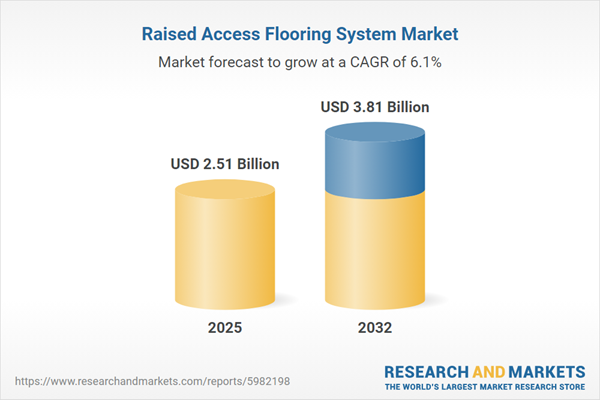Speak directly to the analyst to clarify any post sales queries you may have.
Raised access flooring systems are redefining efficiency and flexibility for modern infrastructure, supporting strategic workplace initiatives and enhanced building performance that senior decision-makers demand. These solutions are now central to digital integration, adaptability, and regulatory compliance for high-performing buildings.
Market Snapshot: Raised Access Flooring System Market Size and Growth
The global raised access flooring system market reached USD 2.37 billion in 2024 and is projected to grow to USD 2.51 billion in 2025, with further expansion at a 6.10% CAGR, ultimately targeting USD 3.81 billion by 2032. This strong growth trajectory is driven by digital convergence, sustainability mandates, and increasing demand for operational agility and technological flexibility in commercial, institutional, and residential spaces.
Scope & Segmentation: Addressing Core Needs Across Applications and Regions
The report delivers granular analysis by covering the following key segments and themes:
- Application Areas: Commercial offices, data centers, education (colleges, schools, universities), healthcare (clinics, hospitals), residential (multi-family, single-family), retail, and transportation hubs.
- Material Types: Aluminum, calcium sulfate, steel, and wood-core panels, reflecting requirements for durability, sustainability, and design flexibility.
- End Users: Commercial enterprises, industrial complexes, institutional bodies (education, government, healthcare), and residential homeowners.
- Load Ratings: Solutions designed for heavy, medium, and light-duty applications to meet varied structural and performance needs.
- Understructure Systems: Stringer-based and stringerless configurations that dictate installation speed, adjustability, and ongoing maintenance.
- Panel Dimensions & Heights: Standard and custom panel footprints (500 x 500 mm, 600 x 600 mm, 800 x 800 mm) and a full range of panel heights (below 80 mm to above 150 mm).
- Finishes: Carpet tile, PVC/LVT, ceramic, stone, and wood-oriented finishes to address both function and aesthetics.
- Regional Dynamics: Americas (North America, Latin America), Europe, Middle East & Africa, and Asia-Pacific, with tailored deployment patterns linked to digital adoption, energy standards, and cost sensitivities.
- Key Providers Analyzed: Leading companies include Tate Access Floors Inc., Milliken & Company, Gerflor SA, Forbo Holding AG, Armstrong World Industries, Kingspan Group, CTF Systems, Biber Bau, Interfloor, and Access Floor Technology.
Key Takeaways for Strategic Decision-Makers
- Raised access flooring has evolved from purely functional infrastructure to a critical asset supporting workstyle transformation, real-time digital monitoring, and sustainability targets.
- Technological advancements are driving integration of sensor networks, smart controls, and modular designs, enabling rapid workspace reconfiguration and streamlined cable management.
- Material innovation emphasizes low-emission, recycled content, and improved end-of-life recyclability, supporting compliance with green building certifications and extended lifecycle value.
- Regional implementation strategies vary: North America and Europe lead in digital and sustainability priorities, while Asia-Pacific leverages cost-efficient manufacturing and seeks premium performance solutions.
- Supply chain partnerships and local production models are increasingly prioritized to safeguard resilience against shifting trade and regulatory conditions, including tariffs.
- Market leadership hinges on integrated service offerings—from digital engagement platforms to closed-loop recycling programs—empowering streamlined project delivery and post-installation support.
Tariff Impact: Strategic Adjustments for Supply Chain Stability
Recent US tariff policies targeting construction materials result in complex supply chain adaptation. Stakeholders are localizing production, diversifying procurement strategies, and forming partnerships with distributors to contain costs and minimize risk. Contract agility and proactive regulatory monitoring support project continuity in this evolving trade landscape.
Methodology & Data Sources
This report employs a mixed-method approach, combining primary interviews with industry stakeholders and quantitative surveys. In-depth review of technical standards, industry publications, and cross-validated vendor specifications underpin robust scenario analysis. Data governance protocols ensure accuracy and ethical integrity in all findings.
Why This Report Matters: Actionable Insights for Leaders
- Gain comprehensive visibility into the forces shaping raised access flooring systems across diverse environments and evolving specifications.
- Access targeted strategies to enhance supply chain resilience, optimize procurement, and foster collaborative partnerships aligned with regulatory and sustainability demands.
The analysis guides decision-makers in implementing innovative, futureproof solutions that anticipate industry trends, align with operational priorities, and elevate stakeholder value.
Conclusion
The raised access flooring system market is positioned for sustained growth, driven by rapid digital integration, evolving regulatory requirements, and rising performance expectations. Aligned investments and responsive supply strategies will determine long-term success for industry stakeholders.
Additional Product Information:
- Purchase of this report includes 1 year online access with quarterly updates.
- This report can be updated on request. Please contact our Customer Experience team using the Ask a Question widget on our website.
Table of Contents
3. Executive Summary
4. Market Overview
7. Cumulative Impact of Artificial Intelligence 2025
Companies Mentioned
The companies profiled in this Raised Access Flooring System market report include:- Tate Access Floors Inc.
- Milliken & Company
- Gerflor SA
- Forbo Holding AG
- Armstrong World Industries, Inc.
- Kingspan Group plc
- CTF Systems, Inc.
- Biber Bau AG
- Interfloor B.V.
- Access Floor Technology Ltd.
Table Information
| Report Attribute | Details |
|---|---|
| No. of Pages | 193 |
| Published | October 2025 |
| Forecast Period | 2025 - 2032 |
| Estimated Market Value ( USD | $ 2.51 Billion |
| Forecasted Market Value ( USD | $ 3.81 Billion |
| Compound Annual Growth Rate | 6.1% |
| Regions Covered | Global |
| No. of Companies Mentioned | 11 |









